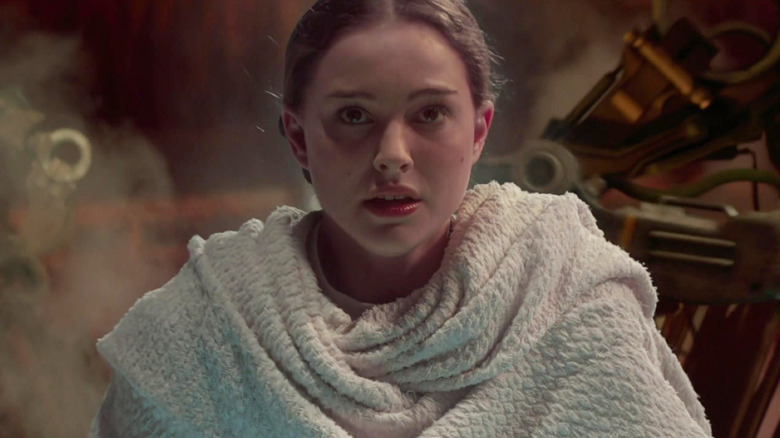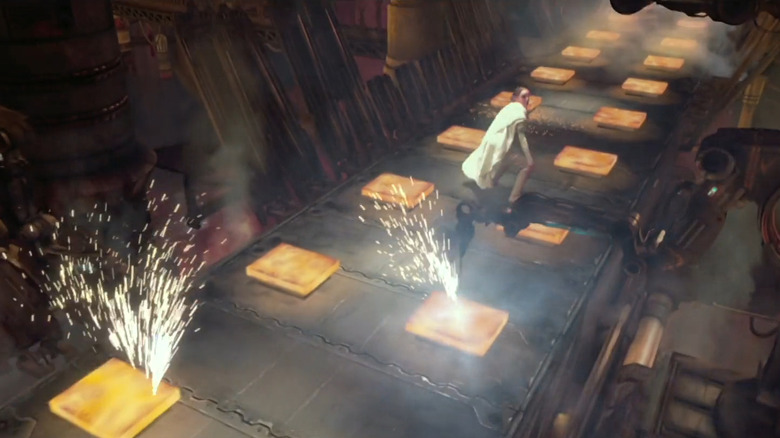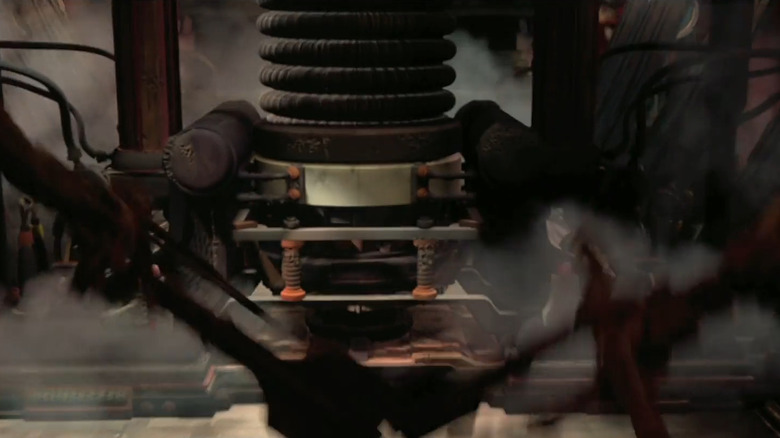George Lucas Put ILM Under The Gun With Last-Minute VFX For Star Wars: Attack Of The Clones
Special effects artists are overworked. Perhaps you've heard some of the complaints from the Marvel Studios VFX artists who have to do an incredible amount of work in very little time. The problem has gotten worse over the years as CGI has become more prevalent. However, time was an issue all the way back when 2002's "Star Wars: Episode II — Attack of the Clones" was in production. There were a lot of sequences that required things that didn't exist on the set, particularly in the Geonosian droid factory scene. You know, the one where Anakin Skywalker (Hayden Christensen) and Padmé Amidala (Natalie Portman) dodge crushing metal stamps and C-3P0 (Anthony Daniels) literally loses his head.
The CGI technology available back in the early 21st century wasn't anywhere near as sophisticated as today's, yet the effects artists at Industrial Light & Magic (ILM) were just as much under the gun blaster as VFX creatives are working in the industry right now. In fact, according to Star Wars Insider issue #67, that droidworks scene wound up feeling very last minute because of all the moving parts, so to speak.
'All that stuff had to be worked out by us'
Watching that scene today (as I just did), it looks a bit like a dated video game. Certainly not realistic by our current standards. (It still looks better than a few scenes in "Ant-Man and The Wasp: Quantumania.") That said, at the time, it was shockingly complex and fascinating to watch. If you recall, the film's heroes are trying to get out of the droid factory all while being stuck on conveyor belts and dodging heavy machinery. According to Insider, the entire sequence was a "late addition" to the film because George Lucas and his editor Ben Burtt wanted another action scene on Geonosis. This resulted in the last-minute creation of a scene involving moving parts, sparks, glowing metal, droids, and close calls in a place that doesn't really exist. Animation supervisor Hal Hickel explained the film's creatives were given animatics, which was great, but there were still puzzles to solve:
"They gave us a terrific sense of movement and the whole flavor of the thing. However, they didn't attempt to solve any of the hundreds of really difficult questions regarding scale of the machines, speed and width of the conveyor, and so on. All that stuff had to be worked out by us."
It was quite the process, going from layouts to shot set-ups by artists who had to determine what needed to be added later in post-production (the animatics left that part out) while figuring out things like how fast the belts were moving, then put it all together with the raw footage of the actors performing against a blue screen. There just wasn't enough time to do the layout phase of planning, but what they were able to do really helped bring the scene to life.
'We'd need more machines to make things interesting'
Next up in the long chain of development were the animators. As Hickel explained:
"Once we combined those layouts with the blue screen match moves, we had a great little layout/blocking version of the sequence that told us right away where we'd need more machines to make things interesting, or where we'd need to take some out to make things read better."
Of course, this also required more time, which the film's creatives didn't have. In fact, according to the Insider article, there wasn't even time to draw the details of the droids' arms. Instead, visual effects supervisor Ben Snow had to create a step-by-step plan of how the factory worked so it could be visualized. Then he took the rest of his team to a car plant to get a better idea of what they were creating and how the moving parts functioned.
Ultimately, the production ended up with 70 computer models for just that sequence. The film's VFX artists then had to get the timing right so the scene made sense, leading them to ideas like shifting colors to differentiate areas and finding ways to make these drawings and renderings look like they had actual mass. Considering the early stages of CGI and effects like this, the scene is pretty easy to follow.
Indeed, you should go rewatch the scene now and consider all the time and effort that went into making the Genosian droid factory a (digital) reality. Effects artists of every stripe work incredibly hard to accomplish these types of sequences and often with little to no recognition (unless it's a complaint about "bad" visual effects, which they probably didn't have enough time to complete).
All the "Star Wars" shows and films are currently streaming on Disney+.


